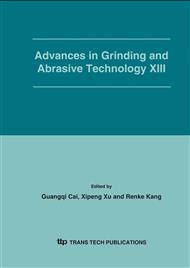p.1
p.8
p.14
p.19
p.24
p.29
p.33
p.38
p.43
Optimising the Process Conditions in Ultra-Precision Grinding to Achieve Surface Finish of Optical Quality
Abstract:
Optical surface finish below Ra 10nm can be achieved on a ‘Tetraform C’ grinder of ultra-high stiffness, when grinding a low alloy steel with or without the help of ELID (electrolytic in process dressing). Surface roughness generation modelling has been carried out to predict thepossible surface roughness values. Efforts have been made to transfer the process knowledge to different grinding mode using a rigid 5-axis Edgetek CNC grinder. The effects of material removal rate and grit size and also that of spark out passes on the surface roughness generated have been investigated.
Info:
Periodical:
Pages:
8-13
Citation:
Online since:
February 2006
Authors:
Price:
Сopyright:
© 2006 Trans Tech Publications Ltd. All Rights Reserved
Share:
Citation:


